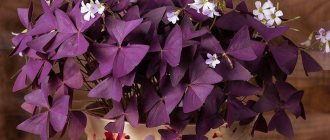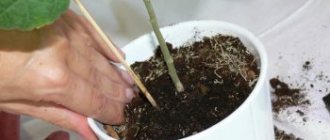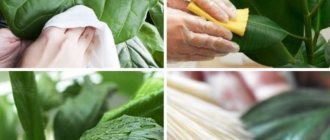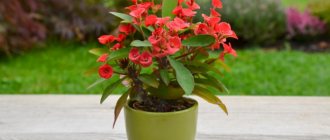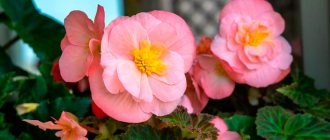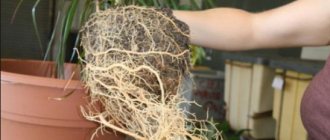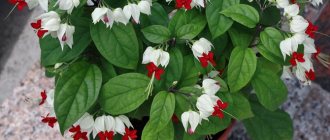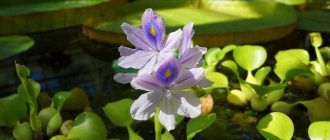The codiaeum flower, otherwise croton, is the most famous Codiaeum variegatum var. pictum, has numerous varieties of different leaf shapes and colors.
It was first described in 1690 by the naturalist and gardener Rumphis, a Dutchman by birth. It is a perennial shrub, reaching a height of up to 4 m in the wild or special greenhouses, and up to 70 cm in indoor conditions. It is a perennial plant of the Euphorbiaceae family. Southeast Asia is considered its homeland.
It has an erect, branched trunk covered with large leaves, up to 30 cm in length. In describing the foliage of codiaum, it is worth mentioning its great diversity. There is no classic or standard appearance for this flower. Leathery leaves can be narrow, long, wide or oval; wavy, jagged or twisted into a spiral. In addition, as the plant ages, the color and shape of the leaves often change.
How the indoor ornamental plant codeium blooms
In its appearance, the flower combines all the shades of the autumn palette. Color varies from yellow and green to orange and red with a finely speckled pattern, with spots, stripes or prominent veins. There are even dark brown, almost black leaves with bright veins. The older the leaf, the brighter its color. It is this riot of colors that attracts the attention of both professional plant growers and amateurs.
The bright codiaum blooms, like many decorative foliage plants, faded and inconspicuously - with small white or barely yellowish flowers, collected in small racemes of 15-20 pieces. Both female and male flowers grow. Male representatives can be recognized by the fluffy stamens on each slightly curled petal, and female representatives by three curved petals.
This rather fastidious plant can grow for more than 15 years under proper conditions. Looks great in spacious, bright rooms, winter gardens and verandas. It is popular among regulars of greenhouse exhibitions and artificial gardens.
For initial reference, below are photos of a beautiful codiaum flower (including a blooming specimen) - study them.
Appearance of Aucuba
Aucuba is a shrub with large decorative leaves.
Aucuba very rarely blooms at home. But when this happens, small apical inflorescences of a red hue appear on it. Against the background of green, leathery, oval-shaped leaves with a serrated edge and golden spots across their entire surface, they look very beautiful. If female and male specimens grow nearby, then after flowering original oblong red fruits are formed, reminiscent in appearance of the berries of dogwood plants. They appear at the end of winter, beginning of spring.
The stem of the plant has woody properties. The leaves on it grow opposite. Their size can reach 20 cm in length and 7 cm in width. The height of aucuba at home can reach two meters.
What is the name of a flower with colored leaves among indoor plants?
Home floriculture is primarily attracted by the opportunity to green the room. And if the bushes growing in pots are also variegated, this will make you doubly happy. So, among indoor flowers with two-color or multi-colored leaves, the most common are:
- Aucuba. It grows in the form of a tree, the leaves are large, leathery, oval in shape, with chaotic golden spots on a green background.
- Begonia. It grows as a lush compact bush or as a hanging form. It is valued mainly for its gorgeous flowering, but it has no less beautiful views with variegated foliage of an asymmetrical oblique shape. Their colors can be pink, red, gray, burgundy and all shades of green.
- Hypoestes. A low and highly branched bush with small green leaves decorated with dense spotting. The spots can be white, pink, red.
- Caladium. A stemless bush with large heart-shaped leaves on long petioles. There are both two-color and multi-color varieties.
- Cordilina. It grows in the form of a small palm tree with elongated leaves. There are red-leaved varieties with darker spots, green-pink or white-green.
- Croton. A small tree with large foliage, shaped like oak leaves.
- Maranta. A large bush with large oval leaves decorated with patterns or colored veins.
- Fittonia. Small lush bushes with creeping shoots and ovate leaves. They have a contrasting pattern or veining.
Indoor variegated flowers are more demanding to grow. First of all, this concerns lighting. It should be good, because in partial shade the bright color fades, and some plants even become green-leaved.
Popular varieties of aucuba
Thanks to the work of specialists from different countries, various varieties of aucuba can now be found on sale. Among them there are plants with green leaves and only in the center or along the edge there are small yellow spots. Some, on the contrary, sparkle with a golden sheen, drowning out the main green background of the leaves. Japanese and Himalayan aucuba are most often grown indoors:
- Japanese aucuba (Aucuba japonica). It grows naturally in the south of the Korean Peninsula and in Japan. There are varieties with green leaves and spotted forms. This species has a large number of forms with yellow spots of different sizes and locations on the leaves. The color of the berries can be not only red, but yellow and white. A beautiful bush-like form can only be created through regular spring pruning. It is recommended to use it as a separately growing tub bush.
A. japonica
- Himalayan aucuba (Aucuba himalaica). The Eastern Himalayas are considered the homeland of the evergreen shrub. A dioecious plant with long pointed leaves that blooms in March and bears red fruits. Loves diffused sunlight and tolerates light shade well. It definitely requires regular pruning of fast-growing shoots.
A. himalayan
Aucuba care at home
Aucuba is a simple, unpretentious indoor plant. But in order for it to sparkle with bright natural colors, you still need to follow certain rules for caring for it.
Aucuba planting
In the same pot, this plant can live and develop successfully for up to 10 years. This must be kept in mind when planting a seedling. A large pot must have good drainage and be sure to have a hole in the bottom of the bowl. The soil mixture must be composed of sand, turf soil and peat. The components are taken in equal quantities. An adult plant is transplanted by carefully transferring it into another container. A sign indicating the need for this procedure is filling the entire volume of the pot with a large number of roots.
Pteris Cretan
An unusually beautiful species of fern, often grown at home. Despite its sophistication, it is unpretentious in care and is a godsend for beginning gardeners.
Pteris leaves are shaped like feathers. Their colors are very beautiful: a white vein in the middle and green edges. The plant loves diffused lighting; shade and bright sunlight are equally destructive to delicate foliage.
Pteris needs a stable, slightly cool temperature of +20…+22°C. The substrate in the pot is kept sufficiently moist, but water does not stagnate.
How aucuba blooms: photo and description
Aucuba is a decorative-leaved, semi-lignified plant ; in a room its height reaches no more than 50-60 cm. In nature, aucuba grows up to 5 m in height. The initially green stem of the plant becomes woody with age.
The leaves are short-petioled, dense, leathery , with a large number of yellow or white spots scattered on a dark green background; the leaf blade is large, ovoid-oval or oblong (in the latter case, the edge is finely serrated). The flowers are small, on short stalks.
These photos show how aucuba blooms:
After flowering it produces very showy red fruits. The fruits are small and very poisonous. A popular, very unpretentious crop for cool rooms. Since aucuba is a dioecious plant, in order for it to bear fruit, it is necessary to have male and female specimens.
It rarely blooms indoors, in March-April.
The most popular types and varieties include:
Japanese aucuba 'Variegata' (A.japonica 'Variegata')
Japanese aucuba 'Dentata' (A. japonica 'Dentata')
Japanese aucuba 'Hillieri' (A.japonica 'Hillieri')
In indoor culture conditions, only Japanese aucuba (A. japonica) is grown.
Of greater interest are not monochromatic green plants, but varieties with variegated leaves covered with yellow spots or specks:
Crotonia
Picturata Variegata
Look at a selection of photos of indoor aucuba flowers of various types:
Below is how to care for aucuba at home.
Varieties and species with names and photos
The plant unites about 20 different species, differing in size, shape and color of the leaf plate. The following are especially popular.
Straight variety
The most unpretentious look . It reaches a height of 3 m.
It has linear or lanceolate leaf blades with slightly serrated edges, colored green or purple. Leaf length is 60 cm, width - 3 cm. It is distinguished by a high, straight stem, covered below with the remains of dying leaves.
Feels comfortable in cool rooms.
Red
Palm lily or Cordyline rubra is a valuable ornamental plant. Can grow up to 4 m.
It has leathery, slightly concave, lanceolate leaves that are dark green with a reddish tint. Leaf length 50 cm, width 4.5 cm. Blooms in summer with lilac flowers. It does not require special care.
Apical
The most popular species for home cultivation. It has a straight thin trunk, which can sometimes be slightly branched. It reaches a height of 2 m.
It has green lanceolate leaf blades with a crimson, red, pale pink border or stripes.
When kept indoors, it remains compact for a long time and does not have a trunk.
Sheet length 50 cm, width 10 cm.
Fruticosis
A plant with one or several thin trunks up to 1.5 cm in diameter. The leaves are lanceolate, veined, 50 cm long and 10 cm wide.
The length of the petiole is 15 cm. In nature it has a green or variegated color with a purple tint. Blooms with loose cream panicles .
Mix
This is not the name given to a specific variety, but to species and varieties of Cordyline collected on one pallet under one name, denoting mixing.
Australis
Incredibly spectacular, yet undemanding, the plant is especially loved by gardeners.
It has rich green or striped narrow leaves up to 3 cm wide and compact attractive bushes. Outwardly it resembles a dracaena .
Mambo with scarlet or purple leaves
The plant has a thin trunk and an unusual color range of leaf blades, which can be rich green, scarlet, bright red, burgundy or purple. At home, the height does not exceed 1.5 m.
With proper care, it can delight you with gorgeous white or red-purple flowers.
Also called king tree.
Southern dracaena
The tallest type . In its natural environment it grows up to 12 m.
It has a rigid, widening trunk and sword-shaped leathery green leaves with a wide central vein of light color. It blooms with white flowers with a pleasant aroma, collected in meter-long panicle inflorescences. Sheet length 90 cm, width 7 cm.
Terminalis
It is distinguished by large lanceolate leaves of various shades: from soft pink and green to brown or burgundy. In nature it grows up to 3 m in height.
It has erect stems, which become bare in the lower part over time, while maintaining an attractive appearance.
Tango
A variety of cordyline apex.
They are small and neat trees with lush tufts of leaves of a non-trivial brown color with white veins and scarlet edging. Moreover, with age, the plant does not lose the splendor of the rosette and its beauty.
How to care for an aucuba plant at home (with video)
Optimal location: all exposures except the south. In summer, the aucuba can be taken outside, but it should be positioned so that it is protected from sunlight, wind and rain.
Temperature requirements: in summer it prefers moderate temperatures, about 20 °C; at higher temperatures the plant quickly ages and loses its leaves. In winter, it is preferable to maintain the air temperature from 8 to 14 °C, but not lower than 5 °C.
Lighting requirements: Aucuba grows well in both bright and shaded areas, but bright, diffused light, without direct sunlight, is preferable. When growing aucuba in winter, the plant requires good lighting.
Watering, spraying: in summer, water abundantly, but so that the top layer of the substrate dries out slightly between waterings. In the autumn-winter period, water moderately. Due to excessive soil moisture, black spots may appear on the leaves. The dry air in summer is calm. Tolerates dry air, but spraying is necessary in the autumn-winter period. For watering and spraying, use soft warm water. When keeping the plant in a room with a temperature between 6–12 °C, spraying should be carried out carefully to exclude fungal diseases.
Feeding: during growth in spring and summer, once a week with mineral and organic fertilizers. When caring for an aucuba flower, feeding should be alternated.
Replanting: Aucuba is one of the crops that do not need frequent replanting, so replant a young plant no more than once every 3–4 years, and an adult plant once every 5–6 years.
You need to replant carefully, as aucuba has fragile and brittle roots. It is best to transfer the plant without destroying the earthen ball into a pot of larger diameter. Pots for growing aucuba should be wide.
In hydroponic culture and when grown on an ion exchange substrate, plants grow well for a long time without transplanting or fertilizing.
Substrate: a mixture of clay-turf, leaf soil, peat and sand (6: 2: 2: 1) or turf, leaf soil, humus, peat and sand (2: 1: 1: 1: 1).
Pruning: in the spring, at the beginning of the growing season, aucuba is pruned. Also, for better tillering, young shoots are pinched.
So, in spring and summer, abundant watering and spraying are necessary, in winter watering is moderate. Fertilizing with complete mineral fertilizer is carried out monthly only during the growing season. Once every two years, the plant is transplanted into fresh substrate and large dishes.
Watch how to care for your aucuba in this video:
Nephrolepis
One of the most popular types of ferns. Huge feathery leaves look impressive both in ampelous compositions and alone. Nephrolepis can be grown as an epiphyte. The pots need to be wide and low, since its root system is small.
The fern with curled, wavy, carved leaves looks original. The culture loves diffused sunlight, fresh air without drafts. In summer, the plant can be taken outside.
Growing nephrolepis is not difficult, but you need to remember that it needs high humidity. To achieve this, it is often sprayed, in hot weather even more than once a day.
Reproduction of aucuba at home by cuttings and seeds
Aucuba is propagated at home by cuttings and seeds.
Seeds are sown immediately after collection, as they quickly lose their viability. It should also be remembered that during seed propagation, varietal characteristics may not be transmitted. Seeds are sown in a moist substrate (peat and sand), covered with glass or a transparent bag, maintained at a temperature of 21 °C, constantly sprayed and ventilated regularly. Shoots appear after a long time. When the seedlings have 2-3 leaves, they are planted in separate pots.
When propagating aucuba by apical cuttings, they are cut in March - April or August - September from shoots of last year's growth. Root in damp sand or a mixture of peat and sand in a greenhouse, maintaining the temperature within 20–22 °C, constantly spraying and ventilating regularly. After the cuttings take root, they are planted in appropriate pots (7–8 cm) in a mixture consisting of turf soil, humus and sand (1: 1: 1/2).
Diseases and properties of aucuba
If it is not possible to provide a cool winter and the plant is kept at room temperature, frequent spraying and good lighting are necessary. At higher winter temperatures, aucuba may shed its leaves. The following problems may also occur: the number of yellow spots on the leaves is reduced (lack of light and nutrition), the leaves turn pale (too bright light), become smaller (lack of fertilizer), fall off (too dry air and high room temperature), the lower leaves turn yellow and premature fall off (irregular watering or sudden temperature fluctuations), the top of the leaf dries out, the leaves turn yellow and fade (excess light), the edges of the leaves dry out (insufficient watering in summer or dry air in winter), black spots on the leaves (overwintering is too warm and dry).
Common diseases of aucuba include late blight - a fungal disease that manifests itself in the fact that brownish-purple spots appear on the leaves, then they turn black, the neck of the plant rots, which soon withers and dies. There are two reasons - either excessive watering or compacted substrate. Since there is no treatment, it is necessary to get rid of the plant along with the pot as soon as possible.
Attention! Aucuba berries and all parts of the plant are poisonous and can cause inflammation of the stomach and intestines, diarrhea and blood in the urine. You need to be careful when working with the plant.
Aucuba is not only an ornamental plant, but also a medicinal plant. In its homeland, Japan, the fruits and leaves are used in folk medicine. To do this, crushed fruits in the form of bandages are applied to superficial wounds. For various types of burns, crushed leaves of the plant are used and applied to the affected areas.
Aucuba has the amazing ability to influence the atmosphere of the home, introducing a spirit of peace and unity. This plant is especially recommended for those in whose home there live self-centered people who are overly confident in their importance.
- Author: Maria Sukhorukikh
Rate this article:
- 5
- 4
- 3
- 2
- 1
(1 vote, average: 5 out of 5)
Share with your friends!
